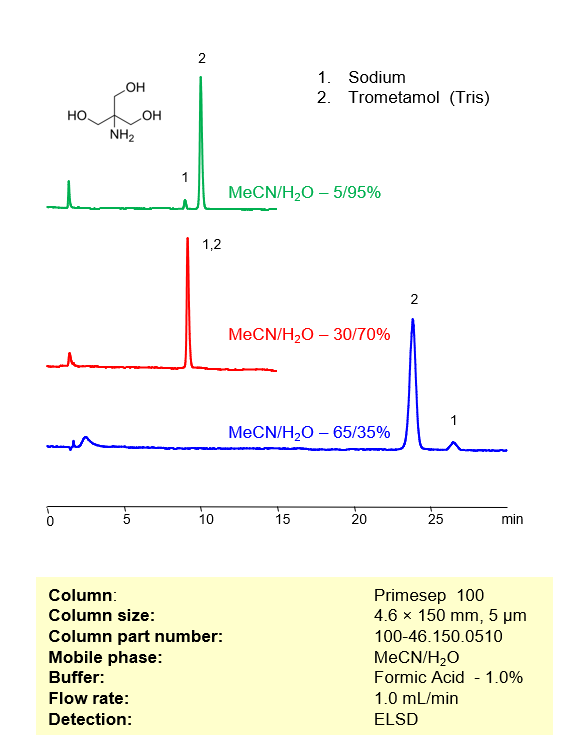HPLC Method for Separation of Trometamol (Tris) and Sodium on Primesep 100 by SIELC Technologies.
Separation type: Liquid Chromatography Mixed-mode

Trometamol, also known as Tris or Tromethamine, is a buffering agent (or Good’s buffer) frequently used in biochemical and molecular biological applicaitons. Tris is often mixed with Sodium Chloride as a buffer, and the Sodium ion and Tris will often co-elute, deliving inaccurate quantitation results. Tris and Sodium ion can be retained, separated, and analyzed on a Primesep 100 mixed-mode stationary phase column using several different isocratic analytical methods with a simple mobile phase of water, Acetonitrile (MeCN), and a Formic acid (FA) buffer. By simply changing the relative concentrations of MeCN and Water, the retention times and order of Tris and Sodium can be significantly manipulated to deliver high quality separations. This analysis method is compatible with evaporative detection methods such as Evaporative Light Scattering Detection (ELSD), Charged Aerosol Detection (CAD), and Electrospray Ionization (ESI) for Mass Spectrometry (LCMS).
High Performance Liquid Chromatography (HPLC) Method for Separation of Trometamol (Tris) and Sodium
Condition
| Column | Primesep 100, 4.6×150 mm, 5 µm, 100A |
| Mobile Phase | MeCN/H2O |
| Buffer | Formic Acid – 1.0% |
| Flow Rate | 1.0 ml/min |
| Detection | ELSD, 40C |
| Peak Retention Time |
Description
| Class of Compounds | Drug |
| Analyzing Compounds | Trometamol (Tris) |
Application Column
Primesep 100
Column Diameter: 4.6 mm
Column Length: 150 mm
Particle Size: 5 µm
Pore Size: 100 A
Column options: dual ended





